Page 206 of 240
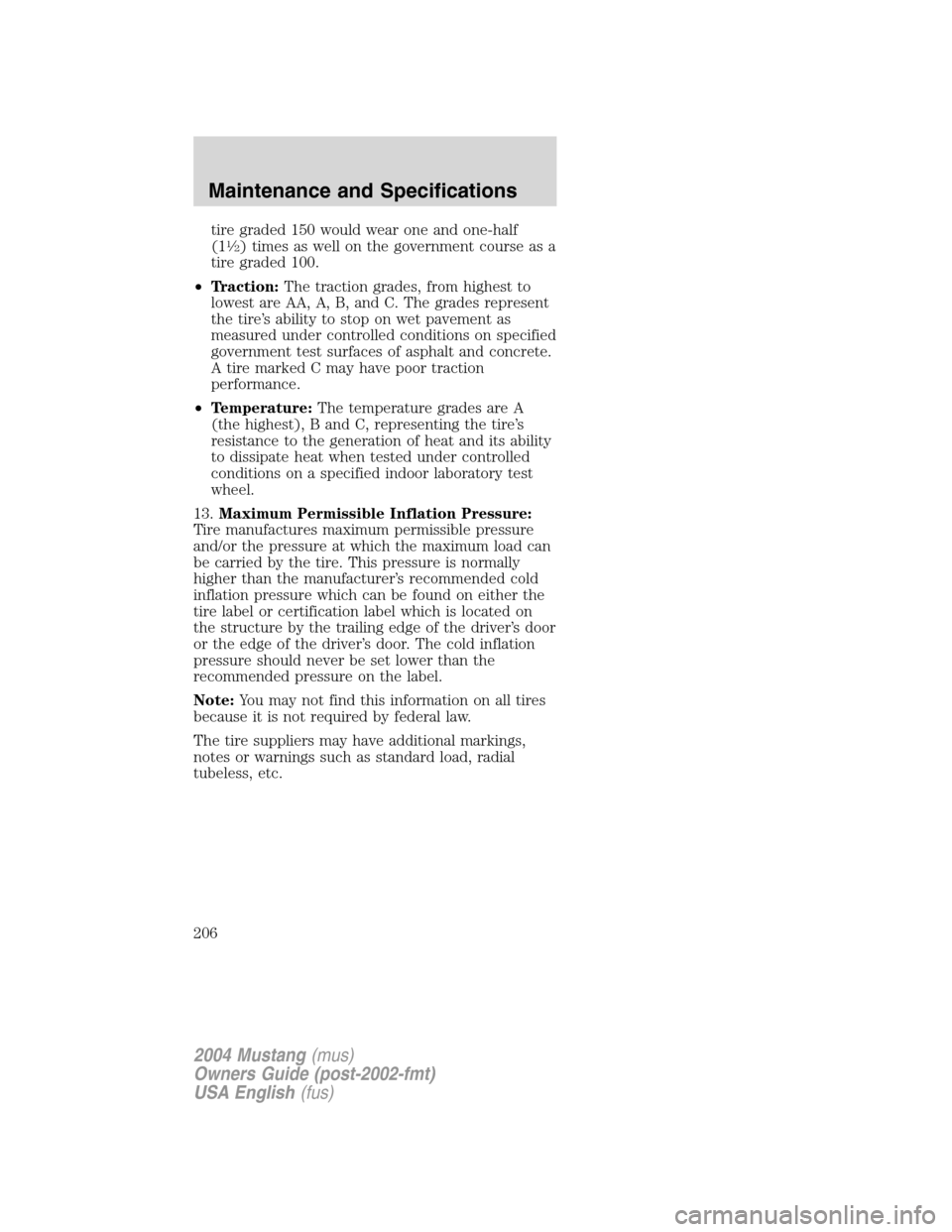
tire graded 150 would wear one and one-half
(11⁄2) times as well on the government course as a
tire graded 100.
•Traction:The traction grades, from highest to
lowest are AA, A, B, and C. The grades represent
the tire’s ability to stop on wet pavement as
measured under controlled conditions on specified
government test surfaces of asphalt and concrete.
A tire marked C may have poor traction
performance.
•Temperature:The temperature grades are A
(the highest), B and C, representing the tire’s
resistance to the generation of heat and its ability
to dissipate heat when tested under controlled
conditions on a specified indoor laboratory test
wheel.
13.Maximum Permissible Inflation Pressure:
Tire manufactures maximum permissible pressure
and/or the pressure at which the maximum load can
be carried by the tire. This pressure is normally
higher than the manufacturer’s recommended cold
inflation pressure which can be found on either the
tire label or certification label which is located on
the structure by the trailing edge of the driver’s door
or the edge of the driver’s door. The cold inflation
pressure should never be set lower than the
recommended pressure on the label.
Note:You may not find this information on all tires
because it is not required by federal law.
The tire suppliers may have additional markings,
notes or warnings such as standard load, radial
tubeless, etc.
2004 Mustang(mus)
Owners Guide (post-2002-fmt)
USA English(fus)
Maintenance and Specifications
206
Page 208 of 240
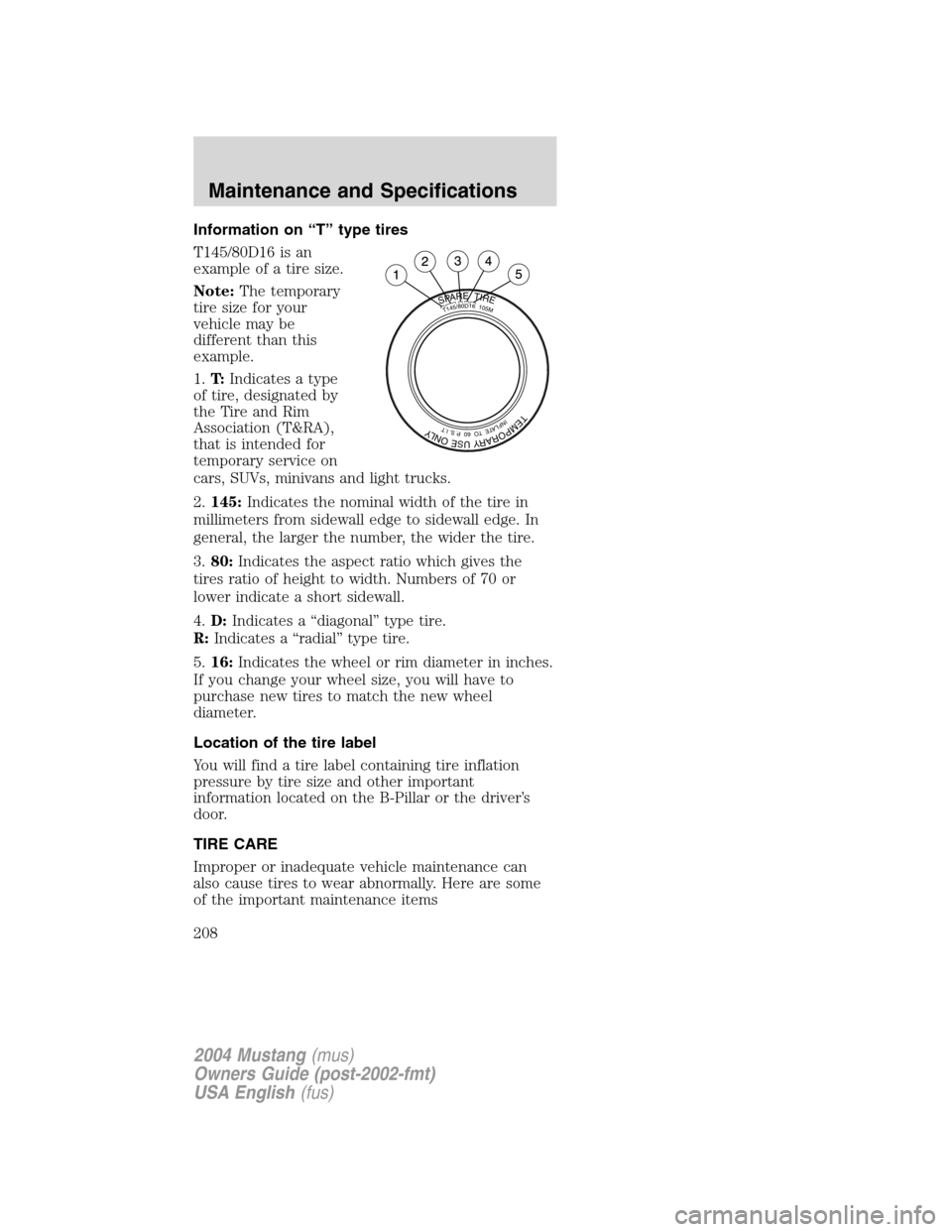
Information on“T”type tires
T145/80D16 is an
example of a tire size.
Note:The temporary
tire size for your
vehicle may be
different than this
example.
1.T:Indicates a type
of tire, designated by
the Tire and Rim
Association (T&RA),
that is intended for
temporary service on
cars, SUVs, minivans and light trucks.
2.145:Indicates the nominal width of the tire in
millimeters from sidewall edge to sidewall edge. In
general, the larger the number, the wider the tire.
3.80:Indicates the aspect ratio which gives the
tires ratio of height to width. Numbers of 70 or
lower indicate a short sidewall.
4.D:Indicates a“diagonal”type tire.
R:Indicates a“radial”type tire.
5.16:Indicates the wheel or rim diameter in inches.
If you change your wheel size, you will have to
purchase new tires to match the new wheel
diameter.
Location of the tire label
You will find a tire label containing tire inflation
pressure by tire size and other important
information located on the B-Pillar or the driver’s
door.
TIRE CARE
Improper or inadequate vehicle maintenance can
also cause tires to wear abnormally. Here are some
of the important maintenance items
SPARETIRE
TEMPORARYUSEONLYINFLATETO60P.S.I.T
T145/80D16105M
2004 Mustang(mus)
Owners Guide (post-2002-fmt)
USA English(fus)
Maintenance and Specifications
208
Page 210 of 240
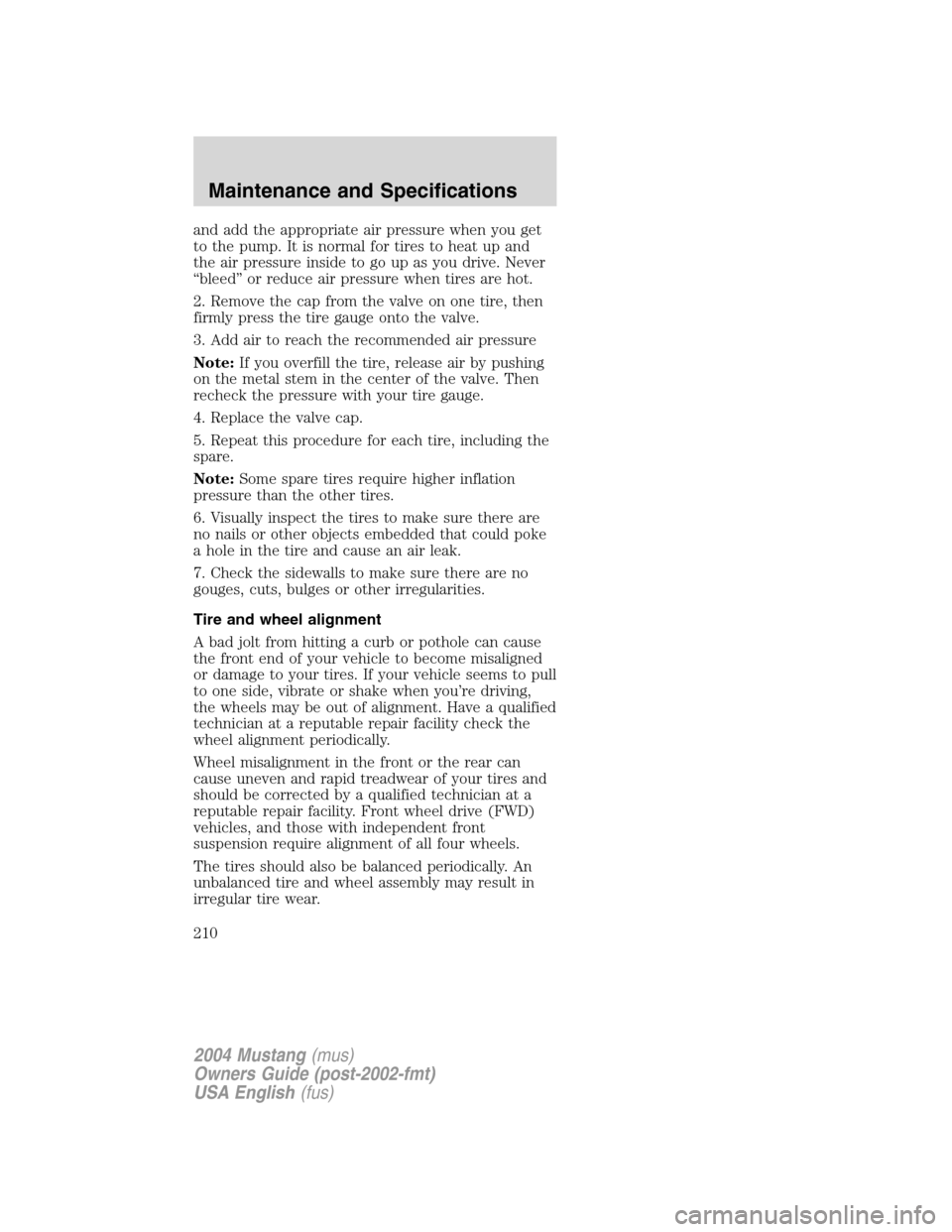
and add the appropriate air pressure when you get
to the pump. It is normal for tires to heat up and
the air pressure inside to go up as you drive. Never
“bleed”or reduce air pressure when tires are hot.
2. Remove the cap from the valve on one tire, then
firmly press the tire gauge onto the valve.
3. Add air to reach the recommended air pressure
Note:If you overfill the tire, release air by pushing
on the metal stem in the center of the valve. Then
recheck the pressure with your tire gauge.
4. Replace the valve cap.
5. Repeat this procedure for each tire, including the
spare.
Note:Some spare tires require higher inflation
pressure than the other tires.
6. Visually inspect the tires to make sure there are
no nails or other objects embedded that could poke
a hole in the tire and cause an air leak.
7. Check the sidewalls to make sure there are no
gouges, cuts, bulges or other irregularities.
Tire and wheel alignment
A bad jolt from hitting a curb or pothole can cause
the front end of your vehicle to become misaligned
or damage to your tires. If your vehicle seems to pull
to one side, vibrate or shake when you’re driving,
the wheels may be out of alignment. Have a qualified
technician at a reputable repair facility check the
wheel alignment periodically.
Wheel misalignment in the front or the rear can
cause uneven and rapid treadwear of your tires and
should be corrected by a qualified technician at a
reputable repair facility. Front wheel drive (FWD)
vehicles, and those with independent front
suspension require alignment of all four wheels.
The tires should also be balanced periodically. An
unbalanced tire and wheel assembly may result in
irregular tire wear.
2004 Mustang(mus)
Owners Guide (post-2002-fmt)
USA English(fus)
Maintenance and Specifications
210
Page 211 of 240
Tire rotation
Rotating your tires at the recommended interval (as
indicated in the Service Maintenance Guide that
comes with your vehicle) will help your tires wear
more evenly providing better tire performance and
longer tire life. Unless otherwise specified, rotate the
tires approximately every 8,000 km (5,000 miles).
•Front Wheel Drive
(FWD) vehicles
(front tires at top of
diagram)
•Rear Wheel Drive
(RWD) vehicles/Four
Wheel Drive (4WD)
vehicles (front tires
at top of diagram)
Sometimes irregular tire wear can be corrected by
rotating the tires.
2004 Mustang(mus)
Owners Guide (post-2002-fmt)
USA English(fus)
Maintenance and Specifications
211
Page 212 of 240
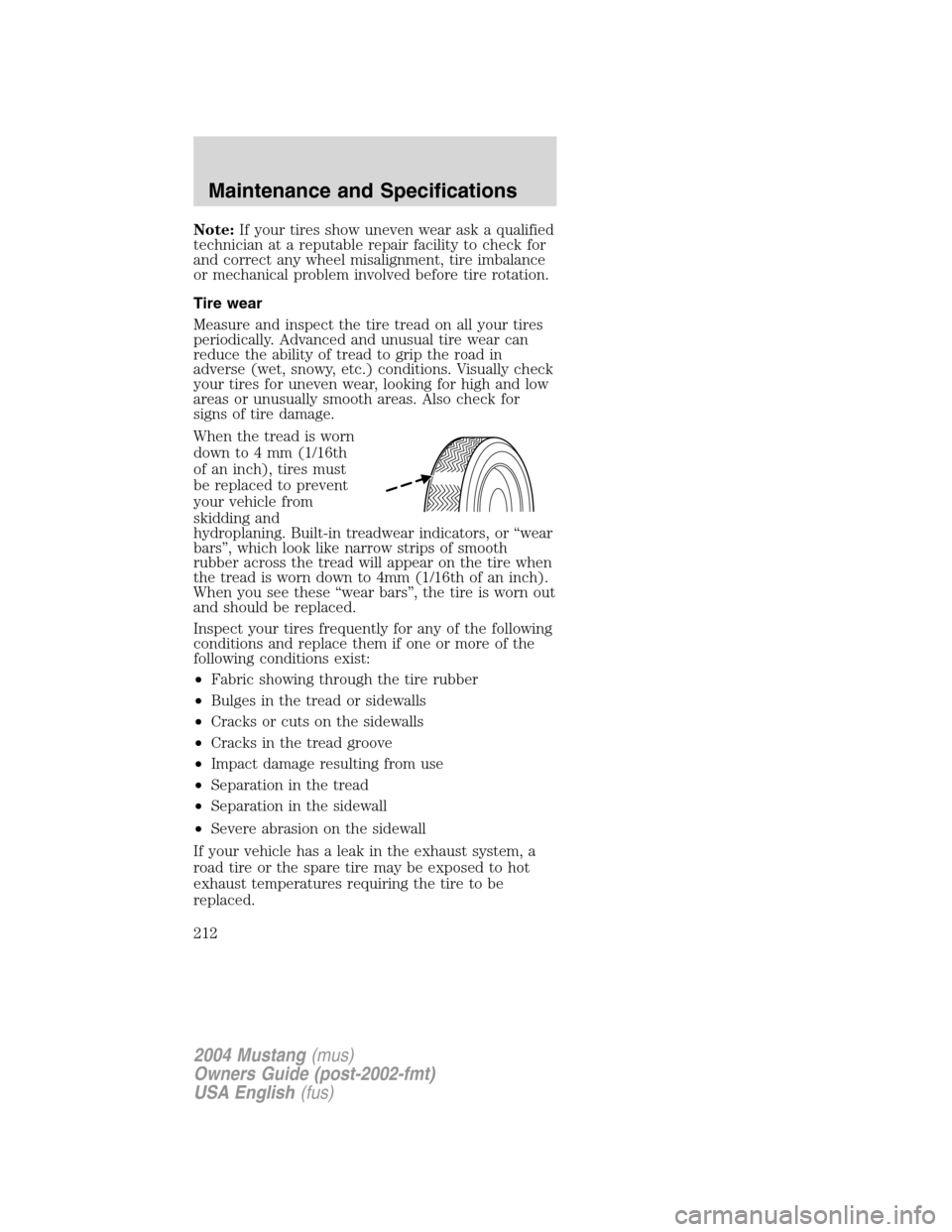
Note:If your tires show uneven wear ask a qualified
technician at a reputable repair facility to check for
and correct any wheel misalignment, tire imbalance
or mechanical problem involved before tire rotation.
Tire wear
Measure and inspect the tire tread on all your tires
periodically. Advanced and unusual tire wear can
reduce the ability of tread to grip the road in
adverse (wet, snowy, etc.) conditions. Visually check
your tires for uneven wear, looking for high and low
areas or unusually smooth areas. Also check for
signs of tire damage.
When the tread is worn
down to 4 mm (1/16th
of an inch), tires must
be replaced to prevent
your vehicle from
skidding and
hydroplaning. Built-in treadwear indicators, or“wear
bars”, which look like narrow strips of smooth
rubber across the tread will appear on the tire when
the tread is worn down to 4mm (1/16th of an inch).
When you see these“wear bars”, the tire is worn out
and should be replaced.
Inspect your tires frequently for any of the following
conditions and replace them if one or more of the
following conditions exist:
•Fabric showing through the tire rubber
•Bulges in the tread or sidewalls
•Cracks or cuts on the sidewalls
•Cracks in the tread groove
•Impact damage resulting from use
•Separation in the tread
•Separation in the sidewall
•Severe abrasion on the sidewall
If your vehicle has a leak in the exhaust system, a
road tire or the spare tire may be exposed to hot
exhaust temperatures requiring the tire to be
replaced.
2004 Mustang(mus)
Owners Guide (post-2002-fmt)
USA English(fus)
Maintenance and Specifications
212
Page 213 of 240
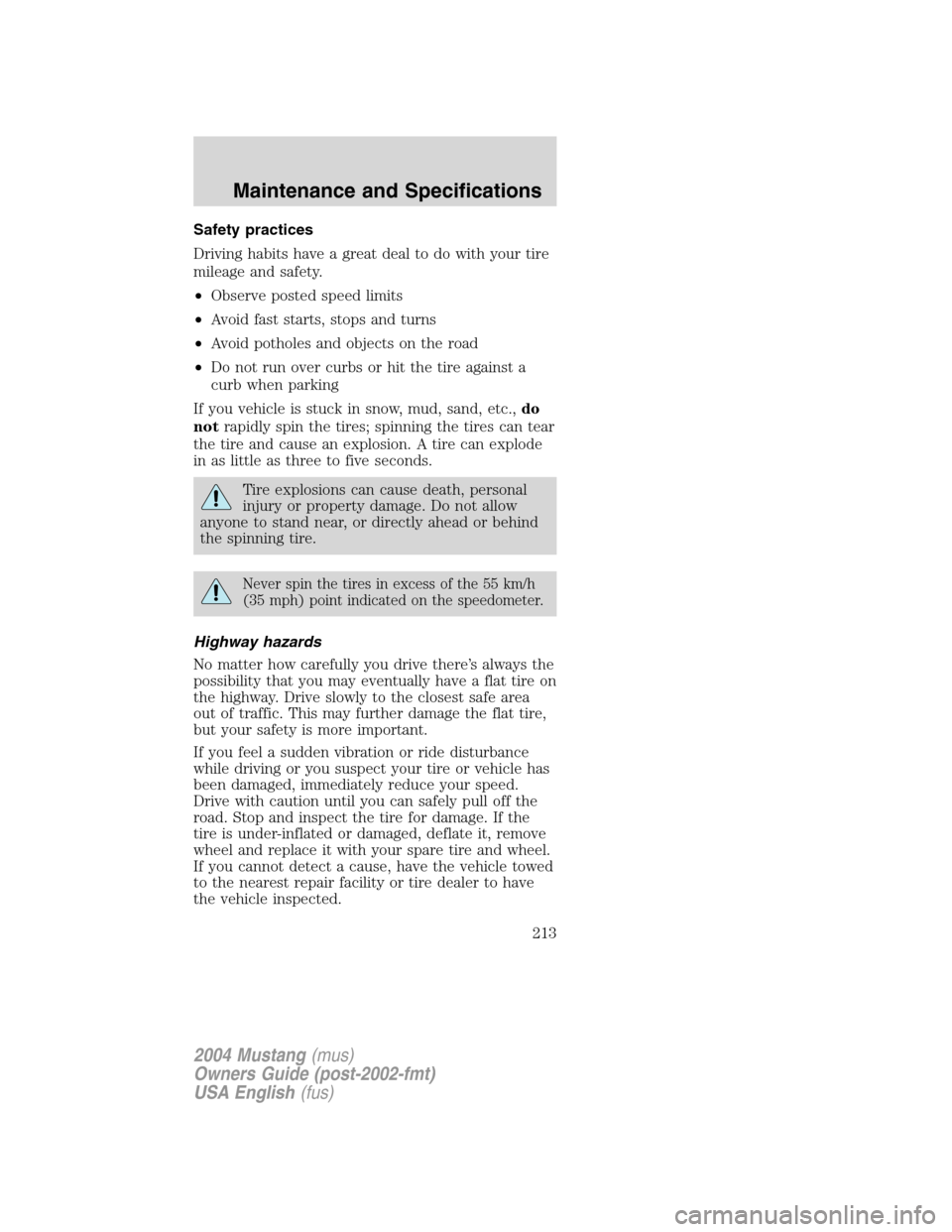
Safety practices
Driving habits have a great deal to do with your tire
mileage and safety.
•Observe posted speed limits
•Avoid fast starts, stops and turns
•Avoid potholes and objects on the road
•Do not run over curbs or hit the tire against a
curb when parking
If you vehicle is stuck in snow, mud, sand, etc.,do
notrapidly spin the tires; spinning the tires can tear
the tire and cause an explosion. A tire can explode
in as little as three to five seconds.
Tire explosions can cause death, personal
injury or property damage. Do not allow
anyone to stand near, or directly ahead or behind
the spinning tire.
Never spin the tires in excess of the 55 km/h
(35 mph) point indicated on the speedometer.
Highway hazards
No matter how carefully you drive there’s always the
possibility that you may eventually have a flat tire on
the highway. Drive slowly to the closest safe area
out of traffic. This may further damage the flat tire,
but your safety is more important.
If you feel a sudden vibration or ride disturbance
while driving or you suspect your tire or vehicle has
been damaged, immediately reduce your speed.
Drive with caution until you can safely pull off the
road. Stop and inspect the tire for damage. If the
tire is under-inflated or damaged, deflate it, remove
wheel and replace it with your spare tire and wheel.
If you cannot detect a cause, have the vehicle towed
to the nearest repair facility or tire dealer to have
the vehicle inspected.
2004 Mustang(mus)
Owners Guide (post-2002-fmt)
USA English(fus)
Maintenance and Specifications
213
Page 214 of 240
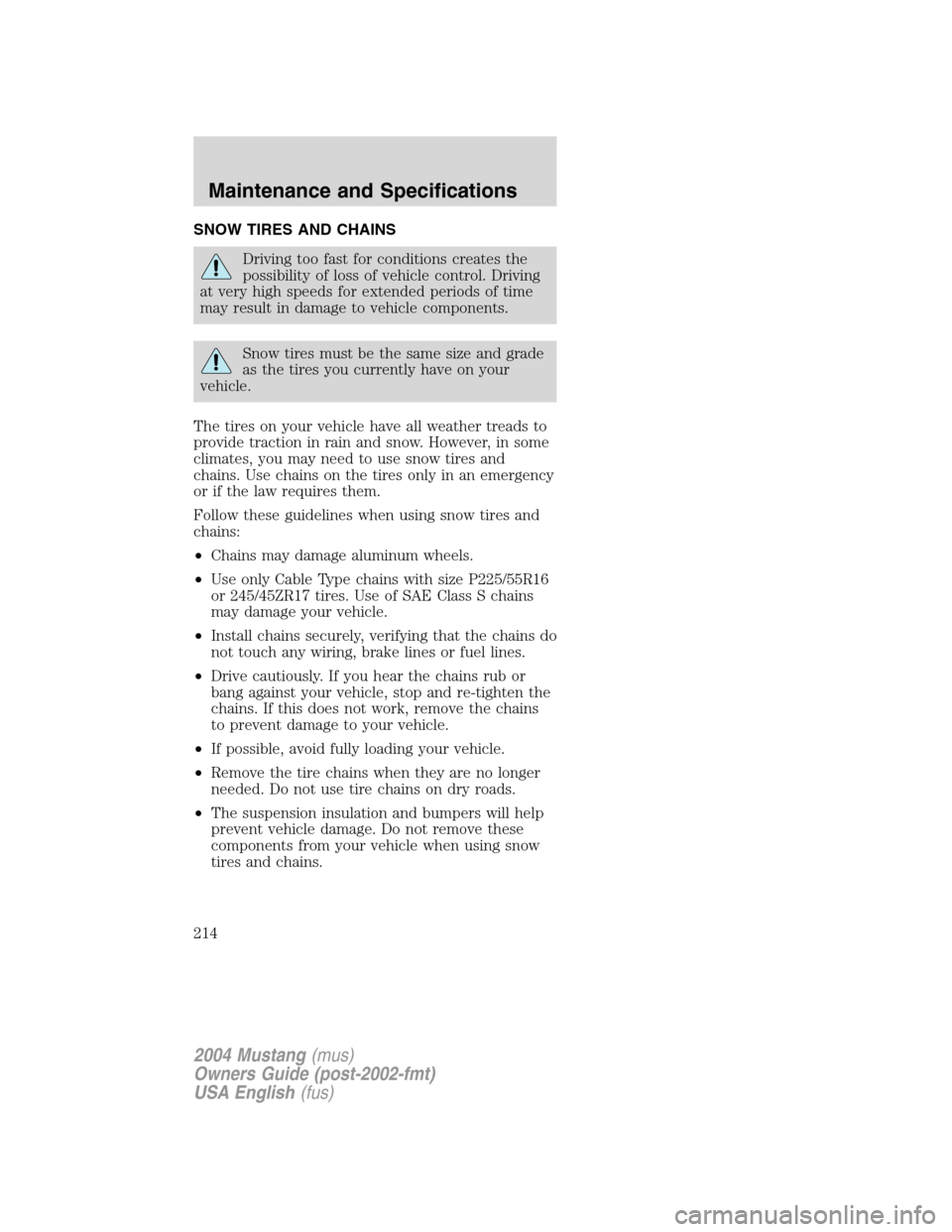
SNOW TIRES AND CHAINS
Driving too fast for conditions creates the
possibility of loss of vehicle control. Driving
at very high speeds for extended periods of time
may result in damage to vehicle components.
Snow tires must be the same size and grade
as the tires you currently have on your
vehicle.
The tires on your vehicle have all weather treads to
provide traction in rain and snow. However, in some
climates, you may need to use snow tires and
chains. Use chains on the tires only in an emergency
or if the law requires them.
Follow these guidelines when using snow tires and
chains:
•Chains may damage aluminum wheels.
•Use only Cable Type chains with size P225/55R16
or 245/45ZR17 tires. Use of SAE Class S chains
may damage your vehicle.
•Install chains securely, verifying that the chains do
not touch any wiring, brake lines or fuel lines.
•Drive cautiously. If you hear the chains rub or
bang against your vehicle, stop and re-tighten the
chains. If this does not work, remove the chains
to prevent damage to your vehicle.
•If possible, avoid fully loading your vehicle.
•Remove the tire chains when they are no longer
needed. Do not use tire chains on dry roads.
•The suspension insulation and bumpers will help
prevent vehicle damage. Do not remove these
components from your vehicle when using snow
tires and chains.
2004 Mustang(mus)
Owners Guide (post-2002-fmt)
USA English(fus)
Maintenance and Specifications
214
Page 221 of 240
ENGINE DATA
Engine OHV V6
engine4.6L SOHC
V8 engine4.6L 4v V8
engine
(Mach 1)
Cubic inches 232 281 281
Required fuel 87 octane 87 octane 91 Octane
Firing order 1-4-2-5-3-6
1-3-7-2-6-5-4-8 1-3-7-2-6-5-4-8
Spark plug
gap1.3-1.4 mm
(0.052-00.056
inch)1.3-1.4 mm
(0.052-00.056
inch)1.3-1.4 mm
(0.052-00.056
inch)
Ignition
systemEDIS Coil on plug Coil on plug
Compression
ratio9.4:1 9.4:1 10.1 :1
VEHICLE DIMENSIONS
Vehicle
dimensionsCoupe mm (in) Convertible mm
(in)
(1) Overall length 4653.3 (183.2) 4653.3 (183.2)
(2) Overall width 1856.7 (73.1) 1856.7 (73.1)
(3) Overall height 1348.7 (53.1) 1351.3 (53.2)
(4) Wheelbase 2571.2 (101.2) 2571.2 (101.2)
(5) Track - Front 1521.5 (59.9) 1521.5 (59.9)
(5) Track - Rear 1526.5 (60.1) 1526.5 (60.1)
25
3
2004 Mustang(mus)
Owners Guide (post-2002-fmt)
USA English(fus)
Maintenance and Specifications
221